Illawarra flame trees are spectacular native trees, indigenous to New South Wales. They are best known for their flowers which come once every three-five years if the conditions are right, but are equally worth growing for their beautiful palmate foliage which spreads like lobed Acer leaves in neat canopies when grown in cultivation.
In this article, we’re going to talk about everything from how to grow flame trees, to how to propagate them and how to encourage them to flower, but more importantly, how to make the most of Illawarra flame trees in your garden.
More...
Genus: | Brachychiton |
|---|---|
Species: | B. acerifolius |
Family: | Malvaceae |
Common Names: | Illawarra flame tree, Lacebark tree, Flame kurrajong, Australian flame tree |
Location: | Outdoor |
Type: | Flowering tree |
Growth: | 10-35m tall |
Sun requirements: | Full sun |
Foliage Colour: | Green |
Flower Colour: | Red |
Flowering: | Late spring to early summer |
Fruit: | Edible seeds (not pods) |
Maintenance level: | Low |
Poisonous for pets: | Seed pods are toxic to many native species, and are serve as irritants if inhaled, or on skin |
What is the Illawarra Flame Tree?
The Illawarra flame tree is one of the most iconic native Australian trees, growing wild throughout New South Wales and the tropical east coast. Its stunning red bell-shaped flowers hang from bright red bracts which cover the tree in spring before the foliage emerges.
The foliage of Illawarra flame tree is palmate (meaning like the palm of a hand, with pointed digits) and described in the botanical name of the flame tree; Brachychiton acerifolius (leaves like an Acer).
The leaves emerge in late spring with a tough waxy exterior filled with moisture and chlorophyll.
Illawarra Flame Tree’s Natural Habitat
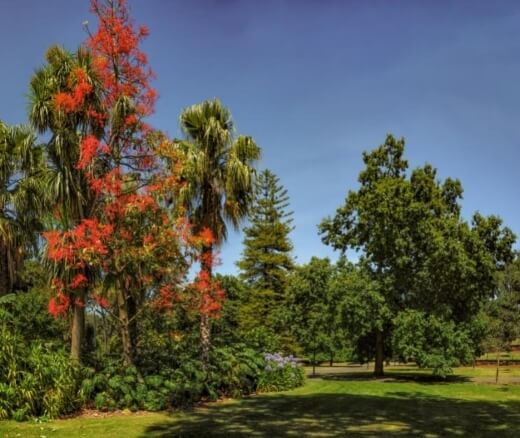
In its natural habitat, the Illawarra flame tree will grow to around 35m tall as a reaction to competition from other trees, and a requirement to outgrow them in order to reach the sun. This is a big clue to how they grow in our gardens.
Ok, so an Illawarra flame tree won’t reach 35m in our gardens, but it should reliably get to around 10m tall, and its root will spread the same distance from the base, so make sure to plant these bright trees well away from the house.
In the rainforests of Eastern Australia, the Illawarra flame tree seeks out the sun, loving to bask its canopy in bright midday light, but keeps its roots shaded to conserve moisture.
This can be difficult to recreate in our gardens without other trees, but a ground covering layer of nasturtiums (learn how to grow nasturtiums here) or geraniums can be an easy-to-manage, alternative way to create shade around the roots of flame trees.
Alternatively, mulch generously with organic compost in spring to help reduce moisture loss and evaporation in summer.
Can You Eat Illawarra Flame Tree Seeds?

Illawarra flame tree seeds are coated in a fibrous mat of hairs which cause severe irritation of the throat, mouth and tongue, and can create extreme skin rashes too.
Despite this, the seeds of these trees are a traditional bush tucker, often used as a replacement for peanuts. They have a very similar flavour to raw peanuts once properly prepared and are easy to harvest after the rare appearance of flowers.
How to Prepare Flame Tree Seeds
Illawarra flame tree seeds are easy to prepare but make sure you wear gloves while handling the seed pods. The seed pods and the seed themselves have a fluffy mass of fibres.
Avoid touching these, or rubbing your eyes while handling them. Then, simply roast the seeds whole which removes the irritating fibres.
Roasting for around 30-45 minutes will provide great edible snacks, but roasting on a lower heat for longer (turning occasionally) can produce dried seeds which can be ground up for a caffeine-free coffee alternative.
How to Grow Illawarra Flame Tree
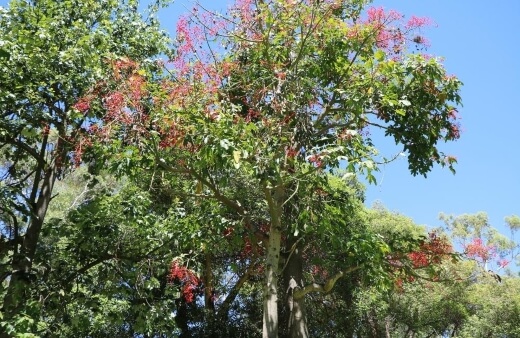
Growing Illawarra flame trees is easy in Australia as these native trees are naturally adapted to our environment. The further south you get, the more important it is to provide a bright sunny spot, where they can benefit from the winter sun, and avoid severe frosts.
Other than that, growing Illawarra flame trees is all about positioning and general care. Firstly, remember that flame trees are predisposed to be big. That means you should never plant them near the house.
Secondly, flame trees will not be happy in containers unless you bonsai them, which will take considerably more work than most bonsai as the flowers and seed pods retain their full size even when bonsaied.
How to Propagate Australian Flame Tree
It is possible to propagate Illawarra flame trees from cuttings, and from seed, but propagating from cuttings is a slow and unreliable process, so it is far easier to wait for seeds to become available, and propagate from them.
If you want to try taking cuttings, try taking greenwood cuttings from Illawarra flame trees in late spring, from a non-flowering branch tip.
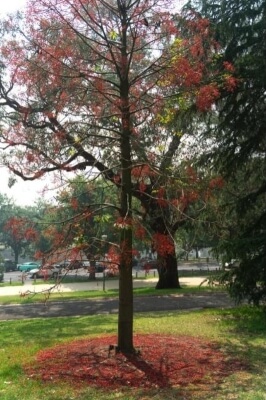
Propagating Illawarra Flame Trees from Seed
Germinating Illawarra flame trees from seed is a very reliable way of propagating new plants. Their seeds are packed with fats and proteins that provide plenty of energy to young saplings.
The only problem is that seeds can be incredibly difficult to get hold of. Before germinating your Illawarra flame tree seeds, you’ll need to prepare them.
Follow the steps below to germinate the Illawarra flame tree from seed:
Tools:
- 9cm plastic pots
- Garden compost
- Horticultural grit
Method:
- Boil a cup of water
- Allow the water to cool slightly so you can touch it without burning
- Using gloves to handle, remove flame tree seeds from their pod, and place them in the water
- Leave the seeds to soak overnight
- Fill small plastic pots with a mix of compost and horticultural grit (3:1)
- Take seeds out of the water and gently dry them off with paper towels
- Push three seeds into each 9cm pot with your finger (about 2cm deep in fine)
- Water, until it runs out of the bottom of the pot and the soil, is saturated
- Leave on a sunny windowsill for 3-4 weeks
- Thin seedlings when they reach 2-3 inches tall, either gently repotting them, or removing the weaker seedlings
- Keep watering when the soil dries out, and pot onto a slighter larger pot after 1-2 months when roots are filling the pot
- After a few months, you should have a tree that’s ready for the garden, but it’s best to keep it containerised until next spring
Illawarra Flame Tree Care Guide

Mulching
One of the most important Illawarra flame tree care tips is to mulch each spring. This isn’t important for nutrients but helps shade the roots providing a more natural environment for these forest trees, who love to have their heads in the sun, but their feet in the shade.
When mulching flame trees, keep a ring around the trunk so the base of the tree can breathe, and add a 1-2” think mulch in a skirt around the roots.
Watering Illawarra Flame Trees
Young flame trees need regular watering to help them establish but will be happy through summer droughts after four or more years in the garden.
Mature native trees tend to be able to survive even the worst droughts, and flame trees are well known for their ability to recover from almost any condition.
Flame trees do not need fertilisers, but if they appear to be suffering in your soil, check the pest and disease guidance below for advice on what fertilisers to use to help boost the health of Illawarra flame trees.
Pruning Australian Flame Trees
Like all native trees, mature flame trees provide excellent habitat for birds. Because of this, it is incredibly important not to prune Illawarra flame trees through late spring, summer, or autumn while the foliage is in place as there may be nests hiding behind the foliage.
Pruning flame trees in winter helps to encourage new growth, and more fanned branches, which can also encourage wider canopies on shorter trees in the long term.
How to Get an Illawarra Flame Tree to Flower
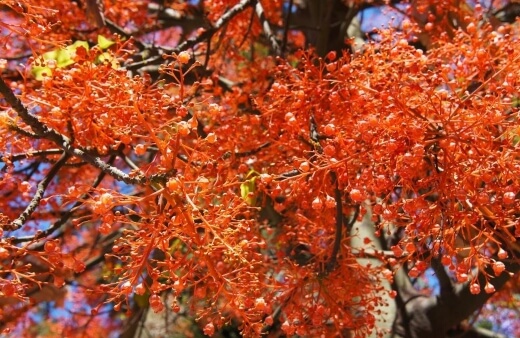
Despite being known for their bright red flowers, Illawarra flame trees usually only flower once every three to five years. Flame trees usually flower the year after warm, wet summers and mild, dry winters.
I adore this affectation of Illawarra flame trees, which is similar to most forest trees, who communicate through underground fungal networks to coordinate their flowering and seed production.
Essentially, if the weather isn’t right for germination, they won’t waste their energy on seed production. This does mean that Illawarra flame trees won’t flower in your garden if they don’t want to, but you will likely notice the same of other local flame trees.
The only way to reliably produce flowers on Illawarra flame trees is to keep them as bonsai trees where you can monitor their environment.
Illawarra Flame Tree Pests and Diseases
Like all native trees, these vibrant flowering trees tend not to suffer from many pests or diseases, but there are one particular set of problems that can be devastating even to mature Illawarra flame trees.
Australian Flame Tree Pests
The Kurrajong leaf-tier is the caterpillar of Dichocrocis clytusalis. The young caterpillars colonise the leaves of native trees and shrubs when they hatch, feeding on young foliage in late spring and early summer and tying leaves up into parcels, or bags, which they then live in until they are ready to migrate as adult months.
This can cause extreme fungal infections, but if your trees are in bright, sunny spots they will usually recover. The best way to deal with these frustrating caterpillars is to cut open the leaf parcels containing the caterpillars, and just sit back and wait for the birds to come and feast on them.
Brachychiton acerifolius Diseases
There are no common diseases for Illawarra flame trees, but an annual feed of general fertiliser can help improve vigour the following year if applied as a soil improver in autumn.
Try chicken manure pellets which leech into the soil over winter during dormancy, and give a nutrient boost in spring as new buds are forming on Illawarra flame trees.
Australian Flame Tree Frequently Asked Questions
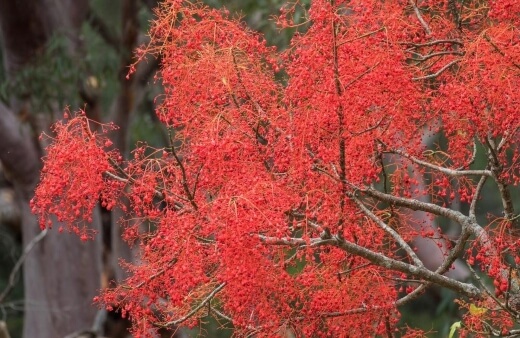
Do Illawarra flame trees lose their leaves?
Illawarra flame trees are deciduous, so lose their leaves in winter. After warm autumns, they will typically hold their leaves until late winter, and quickly replace them with fresh spring growth, but following cooler summers or autumns they will drop leaves in early to mid-winter.
Where do flame trees grow in Australia?
Illawarra flame trees are native to subtropical rainforests in New South Wales but are seen as far north as Cape York in Queensland. They thrive in high heat and can cope with relatively high humidity as well as being drought tolerant, making them a perfect choice for Australian gardens.
How quickly do flame trees grow?
Illawarra flame trees can take between 5-7 years to flower when planted from seed, but will typically grow around 1-2ft per year once their roots establish.
In their native habitat, flame trees will reach over 35m tall, but will usually stop growing upwards at 10m in gardens.
Is the Illawarra flame tree invasive?
Illawarra flame trees are not considered truly invasive as they are native species, but they do readily self-seed and can be a nuisance plant in the garden, with tough, widespread roots which can damage foundations if planted within 10m of a house. The seedlings of flame trees are not deep-rooted so are easy to pull out and control in most gardens.
If you have room in your garden and looking to grow more Australian natives then don't miss our Australian Banyan tree growing guide.

Wrapping Up Our Illawarra Flame Tree Growing Guide
If you want to grow a truly native paradise in your backyard, then Illawarra flame trees are surely up there on your list of must-have plants. We adore these native flowering trees, with bright red bell flowers that attract wildlife, and even provide bush tucker when properly prepared.
Ok, so the thought of a 35m tall tree might put off a lot of gardeners, but remember, that height is an adaptation of their natural forest habitat.
In gardens they stop growing when it becomes a waste of energy, so they will grow until they are the tallest thing around, and then stop and focus all their energy on trying to flower as often as possible.
Published on June 12, 2022 by Maisie Blevins
Last Updated on February 26, 2024





Hi there, I have a couple of Illawarra Flame trees in my front yard and they are not looking great. The branches are scarred and there isn't much of a canopy. I've looked and looked online to find what the problem might be but can't find anything. Confession – I've never mulched the trees but could that be the cause. They are particularly special to us because the trees were germinated from a tree in a previous house which we put our daughters placenta under. Would you be open to me sending you a photograph?
Hi there Phil,
I’m sorry to hear your flame trees aren’t doing too well. Especially considering their importance to you guys. Hopefully, some of this advice can help to reinvigorate them.
So, let’s start with mulching. One of the more important care tips to follow when growing these trees is mulching. It is considered best practice to add a 2.5-to-5-centimetre layer of thick mulch around the base of the trees each spring, so around this time would be perfect.
Not only will the mulch provide your trees with important nutrients but it will also help to shade the roots which will provide a more natural environment for these forest dwellers. Illawarra flame trees love their heads in the sun but their feet in some shade.
When adding your mulch, be sure to keep a ring around the trunks so that the base of your trees can still breathe. Mulching could already help to bring your trees back to their full potential.
For some reference, you can see our article on the best types of mulch for the garden here.
Something else you could try is to cut away some of the damaged branches to help your trees focus their energy on healthy new growth rather than sustaining withering branches leading into the active season now.
Regarding the weak canopies, it could be that your trees are simply not mature enough to produce masses of blooms and foliage as of yet but I don’t know exactly how established they are at this time. Flame trees usually only flower once every 3 to 5 years only if the conditions are right. Perhaps some light pruning in the coming months can also help to encourage more foliage growth.
It’s also important to provide these trees with as much full sun as possible for more prolific growth all-round. Being in your front yard, I imagine they are getting plenty of full sun but if not, perhaps consider moving them to a sunnier location in your garden.
Illawarra flame trees are unfortunately a little temperamental but I believe by actioning some of the above, you will be able to get them looking better soon enough. While you’re tending to them, perhaps even feed them with some fertiliser to further boost their nutrient intake.
I hope this information helps Phil and we look forward to hearing your success story in the near future.
Happy gardening from the AGT team!
I have a Flame tree sapling I wish to bonsai, it's 120mm in hight with a 8mm width trunk. I was wondering at what height will it start branching or will I need to encourage it to start branching.
cheers Jason
Hi Jason,
Thanks for the question.
So ultimately, the Illawarra flame tree is not the best Brachychiton to bonsai. Being such a large growing species, many have struggled to keep it small in containers.
It can be kept in a pot but usually requires occasional repotting into larger containers as it grows.
This tree can take around five to seven years to start seeing proper branching and growth, especially when kept in a pot and not the ground.
If you do choose to give it a go, I would recommend starting to perform heavy cutbacks to the beginning of the tree’s green as soon as possible. I’m not sure exactly how old your sapling is but when it’s around the 2-year mark, heavy pruning two to three times per year should start to encourage healthy branching.
If it does manage to bonsai, be sure to also give it a hot and sunny position and any major branch cuts should be sealed for the best results.
Alternatively, if you do struggle to bonsai your sapling and wish to try another tree in its family, the best species for bonsai is the Queensland bottle tree (Brachychiton rupestris).
I hope this information helps and I wish you the best of luck with your Illawarra flame tree.
Gary Clarke
are the flame tree flowers toxic to native bees, or have I been mislead cheers
Hi Jai,
The flowers of the Illawarra Flame Tree aren’t toxic to bees. I saw something on Facebook about this recently that seems to be gaining traction but it’s just not true. The seeds are toxic to wildlife, but they’re covered in hairs that are so irritating to the skin and mouth that they are pretty much completely incapable of being eaten, and even birds will avoid them.
Like most native plants, they’ve developed ways to protect their seeds, but they’ve also coexisted for thousands, if not millions, of years alongside native insects and wildlife, and both are still here.
Best regards,
Gary Clarke